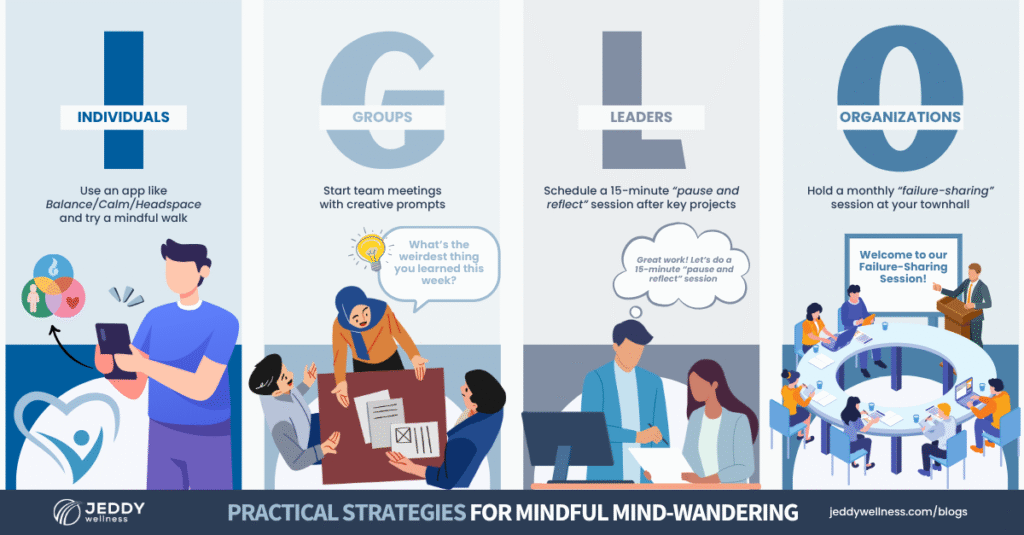Have you noticed your best ideas rarely come from intense focus?
Instead, they often strike during a walk, in the shower, or when your mind drifts.
This isn’t a coincidence , it’s a powerful cognitive state called mindful mind-wandering, and it can protect you from burnout while sparking creativity.
A Quick Throwback
In 2022, I shared 28 strategies in 28 days of February.
One of the most resonant? Mindful mind-wandering.
Let’s dive deeper into why it works and how to make it part of your workday.
Why Burnout Blocks Creativity
Chronic stress and burnout don’t just drain your energy, they also block your brain’s ability to think creatively.
When you’re not burned out, you can access two powerful problem-solving modes:
- Analytical Thinking: You work through problems step by step.
Example: You analyze a missed deadline by checking timelines, tasks, and communication breakdowns. - Spontaneous Insight: Those magical “aha” moments appear when you least expect them. Example: The perfect solution pops into your mind while on a walk or zoning out.
But here’s the catch:
Burnout brings fatigue, brain fog, irritability, and narrowed thinking.
This makes both modes harder to access.
Early burnout symptoms aren’t just exhaustion, they include a shrinking perspective.
That’s where mindfulness and mental spaciousness come in.
Creativity Ranked #5
In 2023, I shared the top 10 skills that 50% of all employees would need by 2025: creativity, originality, and initiative ranked at number five. These aren’t just buzzwords. They’re future-proof traits that help us navigate change, solve complex problems, and thrive in uncertain times (Li, 2022).
While we still navigate uncertainty, practices like mindfulness and intentional mind-wandering can help us strengthen these very skills even in the middle of a hectic workday.
How Mindfulness Enhances Creativity
Mindfulness is the practice of paying attention to the present moment with openness and without judgment. It can be cultivated through meditation, breathing techniques, body awareness, or intentional pauses throughout your day.
- Mindfulness is the nonjudgmental, present-moment awareness of thoughts, feelings, and surroundings.
- Creativity is the ability to generate novel and useful ideas or solutions.
Five Dimensions of Mindfulness
Research identifies five traits of mindfulness that enhance creativity:
1. Observing
Noticing thoughts, emotions, physical sensations, and your environment.
At work: Pay attention to your team’s energy and your own stress cues.
2. Acting with Awareness
Engaging fully in tasks and conversations.
Note: This becomes harder when burned out but also more important.
3. Describing
Clearly naming your feelings and challenges.
Tip: Polished communication leads to more collaborative solutions.
4. Non-Reactivity
Acknowledging emotions without reacting impulsively.
At work: This keeps conflict low and curiosity high.
5. Non-Judging
Being kind to yourself and others, especially when things go wrong.
Bonus: Builds a more open and innovative team culture.
Each of these traits nurtures a different stage in the creative process.
What Exactly Is Mindful Mind-Wandering?
We usually think of mind-wandering as daydreaming or zoning out, a lapse in focus. But when done deliberately and with awareness, it becomes a powerful creative tool. This intentional mental drifting helps your brain:
- Forge new connections
- Integrate unrelated ideas
- Revisit problems from fresh angles
Researchers call this “deliberate mind-wandering,” and when paired with mindfulness, it creates ideal conditions for insight and innovation.
How This Helps in the Workplace
In offices, we often prize focused attention. You know the nose to the grindstone, stay on task, minimize distraction.
But too much focus can backfire.
Research by Dijksterhuis and Meurs (2006) shows that over-deliberation can block insight, while strategic mental breaks improve problem-solving and creative output.
Recovery powers performance.
That’s why employees and leaders can benefit from learning how to use intentional mind-wandering as a tool for learning and problem-solving.
(Note: Strategic mental breaks align with the DRAMMA model of well-being & leisure, which stands for Detachment, Relaxation, Autonomy, Mastery, Meaning, and Affiliation.)
Practical Strategies for Mindful Mind-Wandering
- Individuals: Use a mindfulness app (like Balance) to do a 5-minute guided meditation before starting work.
- Groups/Teams: Start meetings with creative prompts like, “What’s one small change that could make your workday 10% better?” to spark fresh thinking and boost engagement.
- Leaders: Schedule a 15-minute “pause and reflect” session after key projects or meetings where team members briefly share what worked, what didn’t, and one insight about their own reactions or assumptions. This encourages continuous learning and emotional awareness.
- Organizations: At your next townhall, hold a monthly “failure-sharing” session where team members share lessons learned from setbacks without judgment. We often celebrate wins, let’s also normalize talking about setbacks.
When people understand how and why their minds wander, they can direct that process more productively.

Final Thoughts
When we’re burned out, the mind contracts. I know what that felt like.
Basic tasks seem challenging. Brain fog creeps in, routines become rigid, fears of mistakes grow, and creativity dims.
When we’re mindful, the mind expands. It notices more, judges less, and creates space for insight.
The magic happens in the middle in those moments where we let go of rigid focus and allow our minds to explore, without guilt or resistance.
That’s the art of mindful mind-wandering.
It’s a skill worth nurturing.
Written By: Sumana Jeddy
______________________________
Stay Connected with Jeddy Wellness
Discover evidence-based research and innovative strategies to build and activate healthier workplaces.

Before You Add More: Subtract What Drains You
It’s 11:15 PM. Your laptop is still open. You’ve put in 10+ hours every day this week. Your brain feels foggy, your eyes are sore,


